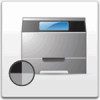Lexmark Monochrome Laser Complete Printer Reference (1.7 MB) - Page 195
Changing input buffer sizes, Multiple port rotation - printer for small business
 |
View all Lexmark Monochrome Laser manuals
Add to My Manuals
Save this manual to your list of manuals |
Page 195 highlights
Changing input buffer sizes If the buffer size the printer automatically assigns is too large or too small, select the amount of memory you want to allocate to the buffer. For example, set the Parallel Buffer menu item to 4MB if your print jobs require more buffer memory than the printer-assigned amount. The minimum amount is generally 3KB (except for the LocalTalk port, which is 6KB, and the infrared port, which is 5KB). The maximum size depends on the amount of memory allocated to all of the input ports. With the exception of the menus for the network ports, all of the buffer size menus offer a Disabled menu item. If you use this menu item to disable ports that aren't being used, the memory normally allocated for those ports is freed up to process print jobs, and becomes available for use by the other input buffers. Increasing the buffer size enables the port to hold more or larger print jobs. Since some applications do not allow you to do any more processing until a complete job has been sent to the printer, increasing the buffer size may return you to your application sooner. The more memory you use for buffers, the less memory is available for processing complex jobs. Multiple port rotation To determine which port has data to process, the printer looks at each port in turn to determine whether or not data is being sent through that port. If the printer detects data on a particular port, it starts to process data on that port. When data on one of the ports is being processed, the printer does not continue to rotate to the other ports. It displays the name of the port in use on the second line of the operator panel display. If the printer receives data on parallel, serial, or infrared ports during this time, the data is received into the input buffer for the particular port. Once the input buffer for the port is full, the port is marked as busy and the host computer is told the printer is busy. If the printer receives data on internal print server or LocalTalk port when the printer is processing data from another port, the data is not received into the input buffer assigned to the network adapter or LocalTalk port. The ISP informs the print server or LocalTalk port that the port is busy, and the print server passes a busy status back to the protocol trying to send data to the printer. Connectivity and network management 195















